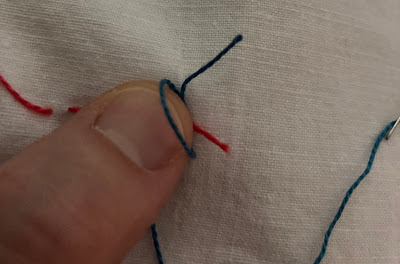This can not be called an embroidery STITCH, but is a KNOT used in sashiko stitching.
Those who are already familiar with the Japanese running stitch embroidery called Sashiko know that the thread is often not knotted. Instead, a form of double stitching is used leaving some stitches slightly thicker than those that have not been worked twice.
There is, however, a knot used to discreetly join an old and a new thread on the reverse of the fabric. This is called Hatamusubi.
Hatamusubi is also used in weaving (Weaver's Knot) and as a nautical knot, it is known as Sheet Bend and Beckett's Bend.
I have two sources for you to check.
A Japanese blog with a diagram and a video. It is easy to understand.
A YouTube video by Stephen Rowley from the UK, showing and describing the work in English.
Here are my photos:
First, let's compare the well-known Square Knot or Reef Knot (white and red)
with Hatamusubi, or Sheet Bend, Beckett's Bend or Weaver's Knot.
You can see how the blue thread is crossed over.
Making these knots with a LONG thread (or rope) is not so difficult.
The trick is to join a very short thread end with the new thread.
So for today's instructions:
You have reached the end of your thread (red)
and only a little bit is left.
How can you join it to the new (blue)
thread?
Place the (blue) tail under the (red)
end.
Press the crossed threads together with your thumb.
Make a loop by taking the (blue) thread under
the (blue) tail and over the (red) tail.
Place the threads as close together as possilble.
Bend the red tail over both blue
threads.
Hold the tails down with your thumb.
Pull the blue working thread, then grab
the red tail and pull into a tight knot.
Snip off the tails as close to the knot as you
can.
Continue with your stitching.
You can see a small bump on the back but,
on the front, there is no sign of the
change of thread, which means it is
a very useful trick.
How can we use Hatamusubi as an embroidery STITCH?
THAT will be this week's homework on these samplers:
















That indeed is a useful tip!
ReplyDeleteI agree, it is very useful!
ReplyDeleteUseful indeed! Is that also the one known as a Surgeon's Knot?
ReplyDeleteI like this!
ReplyDeleteHow clever! I must give that a try. I have a lot of catching up to do here, I've been vacationing, now I'm back and so is the rain.
ReplyDeleteI did not connect the thread using the flag knot, but if you can do this knot, it is a recommended knot for Sashiko.
ReplyDelete